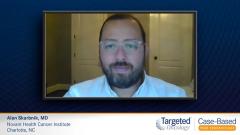
Induction Therapy Options in Follicular Lymphoma
A key opinion leader discusses the considerations in choosing induction and maintenance therapy options for follicular lymphoma.
Alan Skarbnik, MD: In reviewing frontline therapy options, we fortunately have a number of treatments available, but sometimes choosing between treatments may be challenging.
Of course, an anti-CD20 [antibody] plus chemotherapy is usually the most used option, but we can use an anti-CD20 alone for patients who are more frail or with a lower bulk of disease. Some people use lenalidomide plus an anti-CD20. There are 2 anti-CD20s that are approved, obinutuzumab and rituximab, that can be used as frontline agents. Chemotherapy backbones could be bendamustine, CHOP [cyclophosphamide, doxorubicin, vincristine, prednisone], or CVP [cyclophosphamide, vincristine, prednisone]. There are a number of different options to treat these patients.
There are trials that aim to distinguish between those options, and largely bendamustine-based regimens are the most commonly used, based on the StiL and BRIGHT studies showing that bendamustine seemed superior to CHOP or CVP-based regimens in terms of progression-free survival [PFS] and is seemingly overall better tolerated during the induction phase. When there is a question of which anti-CD20 to use, both rituximab and obinutuzumab are both very good options.
The GALLIUM study, which compared rituximab with obinutuzumab with different chemotherapy backbones, showed an improvement in PFS favoring obinutuzumab but with no improvement in survival over rituximab-based treatments.
The study used maintenance strategies after induction with the same anti-CD20 that patients received up front. So 2 years of maintenance with obinutuzumab or two years of maintenance with rituximab, again showing differences in PFS but not in overall survival.
The study that compared rituximab maintenance versus no maintenance used a CHOP and CVP-based chemotherapy, did not include bendamustine, again showing an improvement in progression-free survival in favor of maintenance but no improvement in overall survival between maintenance and no maintenance. This showed that we can salvage patients who present with relapsed disease even without maintenance and provide a long-term PFS after recurrence, particularly if the recurrence happened beyond the initial 2 years post-treatment.
In this case, the patient was treated with obinutuzumab and CHOP chemotherapy. I tend to reserve CHOP-based chemotherapy for either patients who present with grade 3b disease, which would be closer to a diffuse large B-cell lymphoma, or if there is any significant concern for transformation of disease that I cannot prove with a biopsy.
For instance, patients who have widespread disease with very high SUVs [standardized uptake values] in sites that are not easy to biopsy or if patients have very bulky disease, I may favor CHOP. But in most patients, I do favor bendamustine as the chemotherapy backbone if I’m using chemotherapy for induction, given the results of improved outcomes with bendamustine over CHOP in a larger number of patients. But as I said before, there is heterogeneity in these presentations, so physicians may decide differently based on how a patient presents, their age, and other comorbidities.
The patient received obinutuzumab with CHOP chemotherapy and then continued on obinutuzumab maintenance, which is certainly an approved and used approach.
The question of maintenance versus no maintenance is still something that is debated. My opinion is that it should be discussed openly with patients. There are pros and cons. Using maintenance may prolong progression-free survival but again does not have an impact as far as we know on overall survival. But it comes at a cost of increased risk for infections, particularly if patients use bendamustine as the backbone of treatment.
In the setting of a pandemic, we do know that continued use of an anti-CD20 does decrease the efficacy of [COVID-19] vaccines, so it is something that needs to be evaluated with further care and concern for the situation we are in.
Challenges in treating patients with newly diagnosed
To mitigate adverse events in patients who have a high risk for cytopenias or neutropenic fever, using G-CSF [granulocyte colony-stimulating factor] support may be adequate. For some patients who may be at high risk for viral infections or viral reactivations, using prophylactic agents may be adequate as well. Of course antinausea medications and antihyperuricemic medications are used to decrease the risk of tumor lysis syndrome, particularly in the first cycle for patients with bulky disease. Constant monitoring of these patients, addressing adverse effects at each cycle, and adapting the treatments would be appropriate.
Transcript edited for clarity.
A 60-Year-Old Man with Follicular Lymphoma
Initial presentation
A 60-year-old man presents with a 4-month history of fatigue, decreased appetite, occasional fevers, and a 7-lb unintentional weight loss
PMH: Unremarkable
PE: palpable right axillary lymph nodes, ~2.5 cm and bilateral cervical lymph nodes, ~3 cm, spleen palpable 4 cm below left costal margin
Clinical workup
Labs: ANC 1.6 x 10^9, WBC 11.4 x 10^9, lymphocytes 42%, HB 9.7 g/dL, plt 97 x10^9, LDH 402U/L, 3.4 B2M ug/mL; HBV negative
Excisional biopsy of axillary lymph node on IHC showed CD20+, CD3+, CD5+, BCL2+, Follicular lymphoma grade 2
Bone marrow biopsy showed paratrabecular lymphoid aggregates, 38% involvement
Cytogenetics: t(14:18) (Q32;q21)
Molecular testing: EZH2 wild type
PET/CT showed right axillary, bilateral cervical, and mediastinal lymphadenopathy (3.1 cm, 3.1 cm, and 2.6 cm respectively)
Ann Arbor Stage IV, ECOG PS is 1
Treatment
Patient was treated with obinutuzumab plus cyclophosphamide, doxorubicin, vincristine, and prednisone (CHOP) chemotherapy. He completed 6 cycles and treatment was well tolerated.
He continued on obinutuzumab maintenance.
19 months later, he complains of fevers, chills, and worsening fatigue.








































